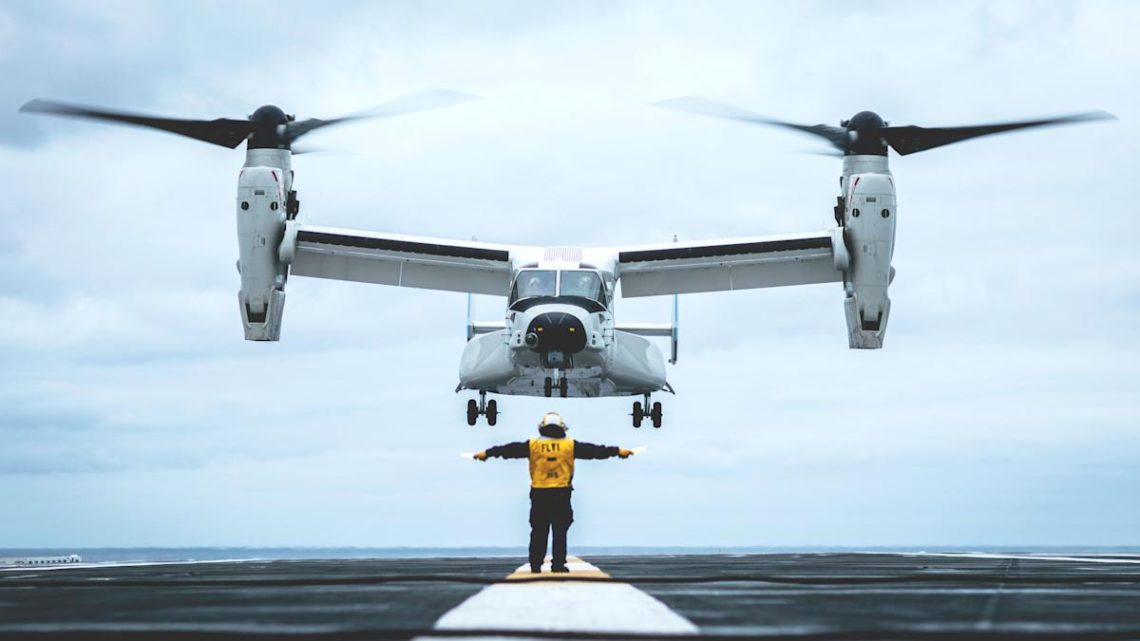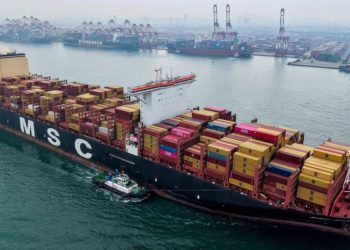A senior Navy aviation officer says the three-month-long grounding of virtually all Osprey tiltrotors worldwide following the fatal crash of a U.S. Air Force CV-22B off the coast of Japan in 2023 sent serious ripples through his service. With Navy CMV-22Bs sitting idle, aging C-2 Greyhound aircraft had to be surged to provide essential logistics support for U.S. aircraft carriers around the globe. While the Navy says it is confident in the Osprey’s ability to perform, the impending retirement of the very last C-2s next year will make it even more critical for the service’s CMV-22B fleet to be ready and reliable.
Rear Adm. Douglas “V8” Verissimo, currently head of Naval Air Force Atlantic (AIRLANT), talked about the CMV-22B and C-2 fleets during a panel discussion at the Navy Sea Air Space 2025 exhibition earlier today, at which TWZ was in attendance. The Navy declared initial operational capability with its version of the Osprey in 2021. The U.S. Marine Corps and Air Force also operate fleets of MV-22B and CV-22B variants, respectively. Currently, the Japan Self-Defense Forces are the only other operator of Ospreys globally.
The 2023 CV-22 crash “was definitely a wake-up call for many of us who are anticipating transitioning from the C-2 to the CMV-22,” Verissimo said bluntly. “The C-2 crews, with some venerable old aircraft, stepped up and took care of business. An unexpected surge in the requirement to maintain carrier onboard delivery [COD] to our aircraft carriers going forward.”
The COD mission and the aircraft that fly it provide logistics and related support to aircraft carriers and their associated strike groups, which is especially key when they are far from friendly ports. This can include delivering and retrieving cargo and/or personnel, as well as other tasks like medical evacuation. COD, in general, is an essential facet of carrier strike group operations and would be particularly critical during a major crisis in the broad expanses of the Indo-Pacific region.
“They mustered from E-2 squadrons to get back to C-2 squadrons to get those dets [detachments] manned and capable to fulfill the tasks,” Verissimo added.
The C-2 design is directly derived from the E-2 Hawkeye carrier-based airborne early warning and control aircraft. The initial variants of both types flew for the first time in the 1960s. New and improved E-2D Advanced Hawkeyes, including a growing number with in-flight refueling capability, are currently set to keep flying in Navy service at least into the 2040s.
“I would say I’m very confident in what that [2023] mishap taught us. I’m very confident in the work that [Vice Admiral Carl] Chebi and our entire team has done in the comprehensive review of understanding that system from a reliability standpoint, from a safety standpoint, and then to really make sure that we’re getting the crews that fly it proficient [again],” the AIRLANT commander continued.
Though the grounding following the 2023 crash was lifted more than a year ago, U.S. military Osprey operators have been following very deliberate and methodical schedules to get back to where they were in terms of operational tempo before the accident. Various significant flight restrictions have remained in place. A final comprehensive review of the incident, which will include a host of recommendations, is still weeks away from being completed. As of June 2024, the expectation was that U.S. V-22 flight operations across the board would not return to a ‘normal’ tempo until the middle of this year.
“I’m confident in the platform. I’m confident in our det [detachment] design, that we can sustain the carrier with the range and the requirements,” Verissimo stressed. “As a matter of fact, the ability to recover a CMV-22 is less limiting than a tail hook aircraft [like the C-2] in many aspects for our carrier onboard delivery. So there is goodness there.”
The Navy has long touted the replacement of the C-2 with the CMV-22 as a game-changer. The Osprey’s ability to take off and land vertically, but still cruise at turboprop-like speeds offers important advantages, including being able to deliver payloads directly to other ships in the strike group and not being tethered to runways ashore. With a C-2, cargo and personnel have to be delivered first to the carrier and then moved to other ships via helicopter.
The CMV-22B can also be refueled in flight, unlike the C-2. Navy Ospreys can land on carriers with a higher gross weight, including fuel and cargo, than a Greyhound and can carry heavy and outsized loads slung underneath the fuselage, as well. The ability to move large cargoes is particularly important for the CMV-22B because of the need to bring spare F135 engines for the F-35C Joint Strike Fighters to carriers at sea.
With the Osprey’s inherent versatility, the Navy has also raised the possibility of the tiltrotors taking on other missions in the future, including acting as communications nodes.
At the same time, the Osprey has been and continues to be a very controversial aircraft with a service record that includes numerous fatal crashes since the Marine Corps became the first operator to declare initial operational capability in 2007. By that point, the V-22 had already struggled through a very problematic and protracted development process.
All Ospreys were grounded again more briefly just last December following another thankfully non-fatal mishap involving an Air Force CV-22. The Marine Corps, which is currently by far the biggest Osprey operator, has consistently contended that the official mishap rate for its MV-22Bs sits firmly within the average for all aircraft types it operates.
With all this in mind, and despite his stated confidence, “the system that underlines the readiness required for the Navy to keep two of three CMV-22Bs ready on the flight deck at all times … needs to be sharpened,” Verissimo said today. “We need to manage that joint program with a Navy focus on what [is] … required to supply the carrier with that needed onboard delivery.”
Earlier in his remarks, the AIRLANT commander had also offered a warning about the backup capability that the remaining C-2 fleet still offers, saying “that train is running out.” Since the 2023 CV-22 crash, the Navy has consistently said it will stick to its current plan to retire the Greyhound fleet for good in 2026.
“So work to be done,” Verissimo said, but “I’m confident we’ll get there.”
In the meantime, if the CMV-22B fleet ends up grounded for a protracted period of time again, there are set to be even fewer, if any, C-2s available to fill the resulting gap to keep Navy carriers supplied at sea.
Contact the author: [email protected]
The post CMV-22 Grounding Was “Wakeup Call” For Navy, Stakes Higher With C-2 Gone Next Year appeared first on THE WARZONE.




